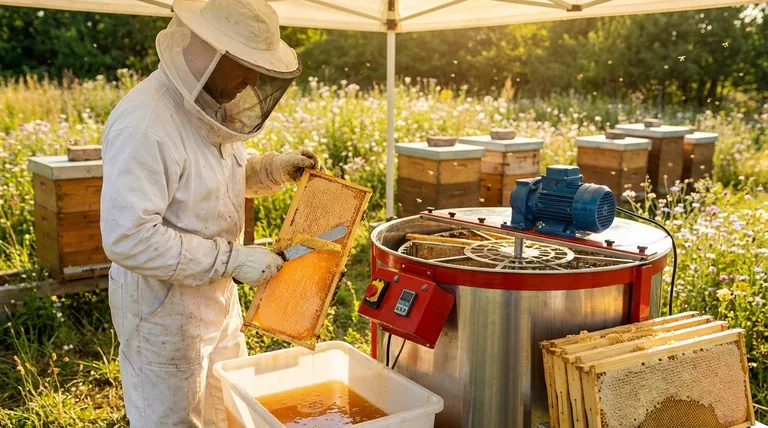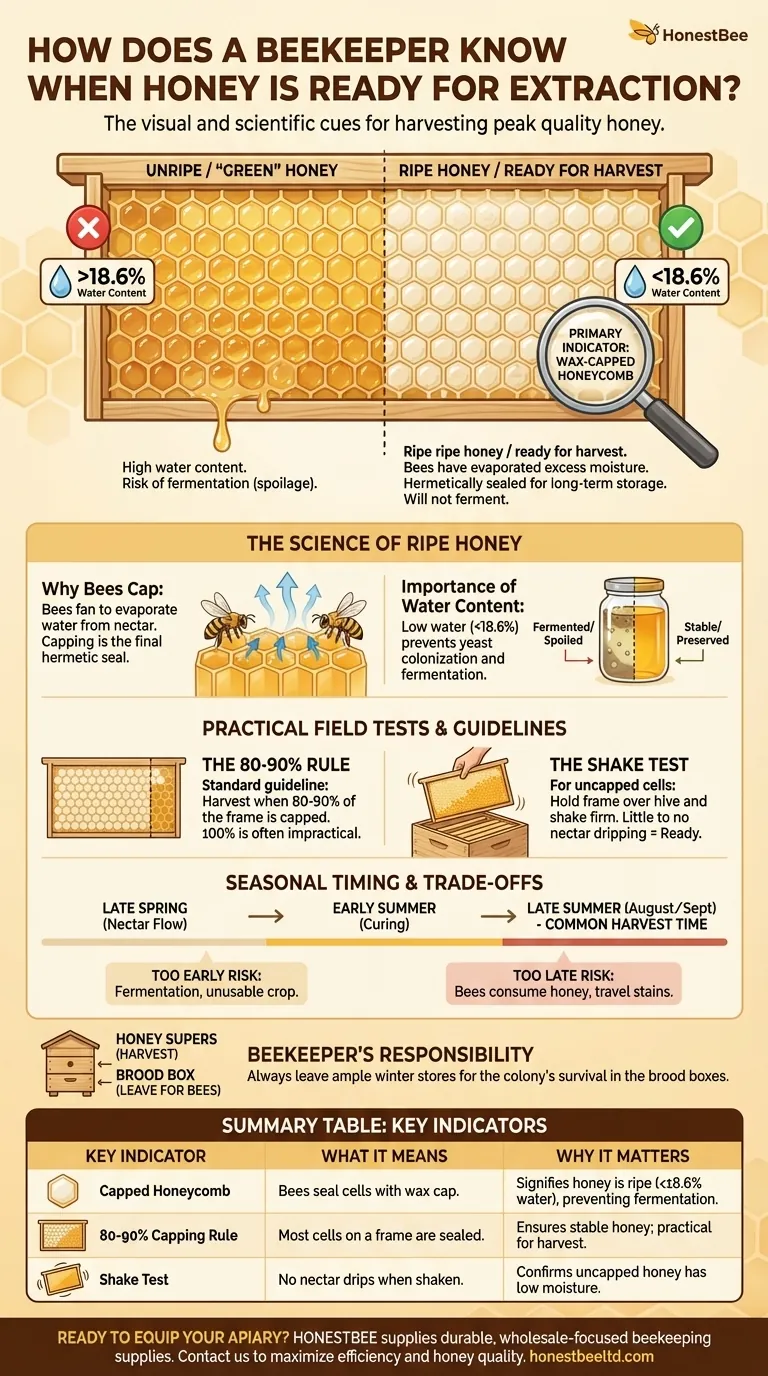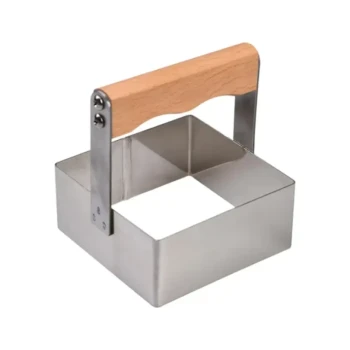To determine when honey is ready, a beekeeper must look for a clear signal from the bees themselves. The primary indicator is "capped honey," where bees seal the fully ripened honey in its honeycomb cell with a fresh layer of white beeswax. This cap signifies that the bees have reduced the honey's water content to the correct level, ensuring it will not ferment.
A beekeeper's goal is to harvest honey at its peak quality, which means extracting it only after the bees have finished their work. The visual cue of a wax-capped honeycomb is the most reliable sign that the honey is "ripe" and has a low enough moisture content to be stored indefinitely without spoiling.

The Science of Ripe Honey
To understand when to harvest, you must first understand why the bees' timing is so critical. The process isn't just about filling cells; it's about creating a stable, preserved food source.
Why Bees Cap Their Honey
Nectar, the raw material for honey, begins with a high water content, often over 50%. Bees actively "cure" the nectar inside the hive by fanning their wings to create airflow, which evaporates excess moisture. When the water content drops below approximately 18.6%, the honey is considered ripe and will not ferment. The wax cap is the final step, a hermetic seal that protects this finished product for long-term storage.
The Importance of Water Content
The single most important factor for stable honey is its water content. If harvested too early ("green"), honey with high moisture will be colonized by naturally occurring yeasts. This causes it to ferment, resulting in a sour taste and spoiled product. The bees' wax cap is the most reliable natural indicator that this critical threshold has been met.
Using the "Shake Test"
Sometimes a frame is mostly, but not entirely, capped. To check the ripeness of the uncapped cells, you can perform a simple field test. Hold the frame horizontally over the open hive and give it a firm, downward shake. If little to no liquid nectar drips out, the honey is generally considered to have a low enough water content for harvest. If nectar sprays out, it needs more time for the bees to dehydrate it.
Reading the Frames: A Visual Guide
Inspecting the frames in your honey supers is the practical application of this knowledge. Knowing what to look for will ensure a successful harvest.
The 80-90% Rule
As a standard guideline, beekeepers consider a frame of honey ready for extraction when 80% to 90% of its cells are capped with wax. Waiting for 100% capping is often impractical, as bees may not cap the outer edges, especially if the nectar flow slows down.
What to Look For
When you pull a frame, you will see a distinct difference between capped and uncapped cells. Capped honey is covered by a dry, whitish-to-tan layer of wax. Uncapped cells are open, and you can see the glistening, wet surface of the honey or nectar inside.
Aligning with the Season
This process of ripening and capping naturally aligns with the beekeeping season. In many regions, the primary nectar flow occurs in late spring and early summer. The bees spend the subsequent weeks curing this nectar, making the late summer months (such as August or September) the most common time for honey extraction.
Understanding the Trade-offs
Harvesting honey involves balancing the desire for a crop with the health and survival of the colony.
The Risk of Harvesting Too Early
As mentioned, the primary risk of an early harvest is fermentation. This renders the honey unusable for human consumption and cannot be sold. It's a waste of both your and the bees' hard work.
Why Not to Wait Too Long
If you leave fully capped honey on the hive for an extended period, the bees may begin to consume it themselves, especially if there is a lack of incoming nectar. Furthermore, dark travel stains can appear on the pristine white cappings over time, making them less appealing.
Always Leave Enough for the Bees
The most critical responsibility of a beekeeper is to ensure the colony has enough food to survive the winter. Never harvest all the honey. A common practice is to only harvest from designated "honey supers" and leave the honey in the lower brood boxes entirely for the bees. The exact amount to leave depends on your climate's winter severity.
Making the Right Choice for Your Hive
Your decision should always be guided by direct observation of the frames, not just the calendar.
- If your primary focus is honey quality: Wait until at least 80% of the cells on a frame are capped with wax, confirming the bees have properly cured the honey.
- If your frames are partially uncapped: Use the "shake test" to ensure the uncapped honey is not too "wet" before deciding to extract.
- If you are planning your first harvest: Be patient and prioritize the colony's health by leaving ample winter stores, even if it means a smaller harvest for yourself.
Ultimately, successful honey harvesting comes from trusting the signals the bees provide.
Summary Table:
| Key Indicator | What It Means | Why It Matters |
|---|---|---|
| Capped Honeycomb | Bees seal cells with a wax cap. | Signifies honey is ripe with water content below 18.6%, preventing fermentation. |
| 80-90% Capping Rule | Most cells on a frame are sealed. | Ensures honey is stable and ready for harvest without waiting for 100% capping. |
| Shake Test | No nectar drips when frame is shaken. | Confirms uncapped honey has low moisture content and is safe to extract. |
Ready to equip your apiary for a successful harvest? HONESTBEE supplies durable, wholesale-focused beekeeping supplies and equipment to commercial apiaries and distributors. From honey extractors to protective gear, we help you maximize efficiency and honey quality. Contact us today to discuss your needs and explore our product catalog!
Visual Guide

Related Products
- HONESTBEE 72 Frame Industrial Electric Honey Extractor for Beekeeping
- HONESTBEE 3-Frame Manual Acrylic Honey Extractor
- electric honey extractor honey centrifuge 3 frame honey extractor stainless steel honey frame extractor
- Plastic Hand Crank 2 Frame Honey Extractor Low Price
- 6 Frame Manual Stainless Steel Honey Extractor Beekeeping Equipment
People Also Ask
- Can a manual extractor be upgraded to an electric one? Save Labor & Boost Efficiency
- How is honey harvested from Langstroth hives? A Guide to Efficient, Comb-Preserving Extraction
- How do automatic honey extractors function? Achieve High-Efficiency Honey Harvesting
- What is the energy consumption like for automatic honey extractors? Maximize Your Harvest Efficiency
- What are the advantages of automated honey extractors in terms of time efficiency? Boost Your Harvest Speed



















